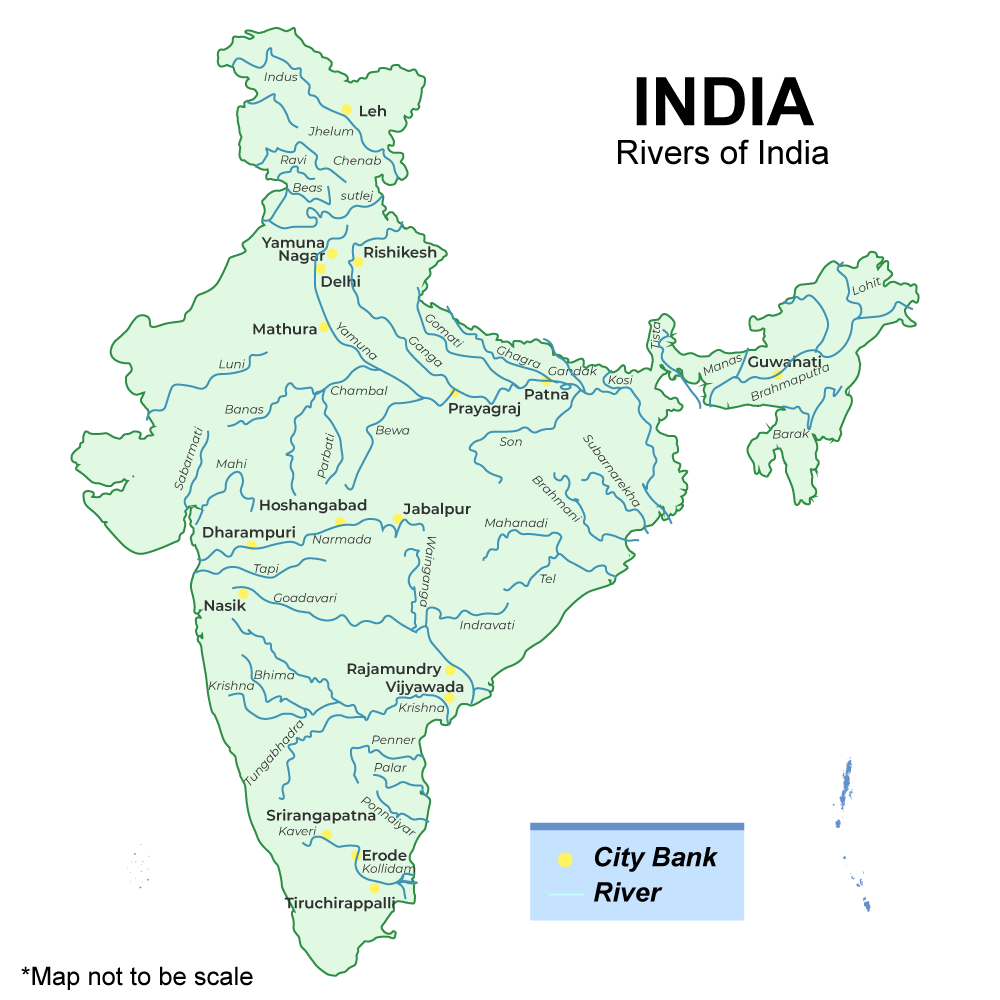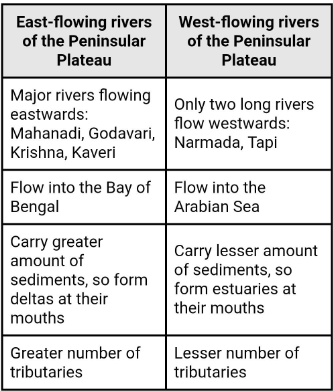Drought in East Flowing Rivers | 16 Apr 2024
For Prelims: East and West Flowing River, Ganga River System, Peninsular Rivers
For Mains: Difference between East and West Flowing Rivers, Droughts, Water Crisis and Management
Why in News?
At least 13 east-flowing rivers between Mahanadi and Pennar have no water at the moment, according to an analysis of data released by the Central Water Commission (CWC).
What is the Crisis Faced by the East-Flowing Rivers in India?
- Water Crisis in East-Flowing Rivers Basin:
- At least 13 east-flowing rivers between Mahanadi and Pennar have no water at the moment, including Rushikulya, Bahuda, Vamsadhara, Nagavali, Sarada, Varaha, Tandava, Eluru, Gundlakamma, Tammileru, Musi, Paleru, and Munneru.
- These rivers flow through the states of Andhra Pradesh, Telangana, and Odisha, draining directly into the Bay of Bengal.
- The storage in the basin has been declining continuously this year, reaching zero on 21st March, compared to 32.28% of the capacity at the same time last year.
- Water Crisis in Other River Basins:
- The Cauvery, Pennar, and east-flowing rivers between Pennar and Kanniyakumari are also facing deficient or highly deficient water storage.
- The Ganga basin, the largest basin in the country, has recorded water storage at less than half of its total capacity, lower than the corresponding period last year.
- Narmada, Tapi, Godavari, Mahanadi, and Sabarmati river basins have also recorded storage levels relative to their capacities.
- National Water Crisis:
- India's 150 major reservoirs have only 36% of their total capacity in live storage, with at least six reservoirs recording no water storage.
- Around 286,000 villages in 11 states located on the Ganga basin are experiencing a decline in water availability.
- Overall, at least 35.2% of the country's area is under abnormal to exceptional degrees of drought, with 7.8% under extreme drought conditions and 3.8% under exceptional drought.
- States like Karnataka and Telangana are grappling with drought and drought-like conditions due to rainfall deficits.
Central Water Commission (CWC)
- The Central Water Commission is the apex technical organisation in the country for the development of water resources and is an attached organisation of the Ministry of Water Resources.
- The Commission is responsible for initiating, coordinating, and furthering, in consultation with the State Governments, the schemes for control, conservation, development and utilization of water resources throughout the country for the purpose of irrigation, flood management, power generation, navigation etc.
Difference between East and West Flowing Rivers:
What are the Reasons for the Drying of East-Flowing Rivers?
- Deforestation and Soil Erosion: Deforestation along the river banks and in the catchment areas has reduced the soil's ability to retain water, leading to reduced groundwater recharge and lower river flows.
- Climate Change: Changing weather patterns, including irregular rainfall and increased temperatures, are affecting the flow of these rivers. Climate change can lead to prolonged droughts, reducing the water flow in rivers.
- Construction of Dams: The construction of dams and water diversion for irrigation purposes has also reduced the downstream flow of rivers, impacting the river's natural flow patterns and ecosystems.
- Water pollution from industrial, agricultural, and domestic waste, as well as invasive species like water hyacinths, degrades river water quality, harming aquatic life and overall river health.
- Sand Mining: Unregulated sand mining along the river beds has disrupted the river's flow and caused erosion, leading to the drying up of river stretches.
- Urbanisation and Encroachment: Urban expansion and encroachment along river banks have altered the natural flow of rivers and reduced the availability of water for the river.
- Lack of Awareness and Conservation Efforts: Limited awareness about the importance of river conservation and lack of effective conservation measures contribute to the drying up of these rivers.
What Measures are Necessary to Address the Issue of River Drying?
- Water Conservation Measures: Implementing water conservation techniques such as rainwater harvesting, watershed management, and soil moisture conservation can help replenish groundwater.
- It will reduce reliance on river water, which will contribute to maintaining the minimum flow of water in the rivers.
- Efficient Irrigation Practices: Encouraging farmers to adopt efficient irrigation practices such as drip irrigation and sprinkler irrigation can reduce water wastage and ensure sustainable use of water resources.
- Afforestation and Vegetative Cover: Increasing vegetative cover through afforestation and reforestation can help maintain river flow by reducing soil erosion and increasing groundwater recharge.
- Regulation of Groundwater Extraction: Implementing strict regulations on groundwater extraction can help maintain the base flow of rivers and prevent their drying up.
- Interlinking of Rivers: Exploring the feasibility of interlinking rivers to transfer surplus water from water-rich regions to water-deficient regions can help in maintaining river flow. For example Ken-Betwa River link project.
- Community Participation: Involving local communities in water management and conservation efforts can ensure sustainable use of water resources and maintain river flow.
- Policy Reforms: Implementing policy reforms to promote sustainable water management practices and regulate water use can help in combating the drying up of rivers.
- Research and Development: Investing in research and development of new technologies and practices for water conservation and management can help in finding innovative solutions to combat the problem.
Conclusion
- While overall storage levels in many river basins are currently reported as 'better than normal' or 'normal' compared to the average of the last five years, it is crucial to note that certain areas within these basins are grappling with severe to exceptional drought conditions.
- This disparity is alarming, particularly due to its adverse effects on agriculture, livelihoods, and the socio-economic fabric of the affected regions.
- Urgent and targeted interventions are imperative to mitigate the impact of these drought conditions and safeguard the well-being of the affected communities.
|
Drishti Mains Question: Q. Examine the impact of the water crisis caused by the drying up of east-flowing rivers. Also, mention the measures to tackle these crises and their implications for sustainable water management. |
UPSC Civil Services Examination Previous Year Question (PYQ)
Prelims:
Q. The Narmada river flows to the west, while most other large peninsular rivers flow to the east. Why?(2013)
- It occupies a linear rift valley.
- It flows between the Vindhyas and the Satpuras.
- The land slopes to the west from Central India.
Select the correct answer using the codes given below:
(a) 1 only
(b) 2 and 3
(c) 1 and 3
(d) None
Ans: (a)
Q. Consider the following statements: (2009)
- There are no east flowing rivers in Kerala.
- There are no west flowing rivers in Madhya Pradesh.
Which of the statements given above is/are correct?
(a) 1 only
(b) 2 only
(c) Both 1 and 2
(d) Neither 1 nor 2
Ans: (d)
Mains:
Q. Drought has been recognized as a disaster in view of its spatial expanse, temporal duration, slow onset, and lasting effects on vulnerable sections. With a focus on the September 2010 guidelines from the National Disaster Management Authority (NDMA), discuss the mechanisms for preparedness to deal with likely El Nino and La Nina fallouts in India. (2014)


